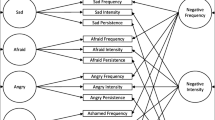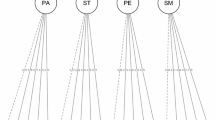Abstract
The Affective Control Scale (ACS) is a widely used measure of fear of emotion. Although the scale as a whole has good utility and predictive validity, there is little work on the specificity of the subscales of the ACS, which measure fear of anxiety, anger, depressed mood and positive mood. In the present study, we investigated the unique relations between fear of specific emotions and the everyday experience of those emotions. We sampled 120 undergraduate students and tracked their emotional experiences over the course of a week using ecological momentary assessments. We found evidence for specificity in the predictive validity of the subscales. After controlling for common variance across the subscales, fear of anger, anxiety, and depressed mood uniquely predicted greater daily experience of the corresponding emotion. These data also support the notion that those who fear specific emotions tend to experience more of those emotions in everyday life.
Similar content being viewed by others
Notes
In this study, the factor analysis suggested a fifth factor in addition to the original four subscales. The authors labeled the factor “emotion mismanagement.” However, the authors also noted that the scale was comprised entirely of reverse scored items and hence the separation of these items in the factor analysis might be a methodological artifact.
While the subscale is labeled fear of “depressed mood,” based on emotion theory it could also be considered fear of depressive emotions/sadness because their fear is triggered by the momentary experience of sadness and it’s potential consequences not the pervasive and sustained emotional climate of sadness (emotion not mood). Furthermore, depression as it is used in the items refers more to sadness than to clinical depression (e.g. “Depression could really take me over, so it is important to fight off sad feelings,” “When I start feeling ‘down,’ I think I might let the sadness go too far,” and “Being depressed is not so bad because I know it will soon pass [reverse scored]”). However, for continuity with the scale we have retained/use the original name in this paper.
We controlled for anxiety and depression symptoms in order to account for current mood states. We also added a control for neuroticism, which is a predisposition toward negative emotionality. The results remained the same, with the exception that the relationship between ACS anxiety and everyday anxiety became non-significant.
References
Beck, J. G., & Davila, J. (2003). Development of an interview for anxiety-relevant interpersonal styles: Preliminary support for convergent and discriminant validity. Journal of Psychopathology and Behavioral Assessment, 25(1), 1–9.
Berg, C. Z., Shapiro, N., Chambless, D. L., & Ahrens, A. H. (1998). Are emotions frightening? II: An analogue study of fear of emotion, interpersonal conflict, and panic onset. Behaviour Research and Therapy, 36(1), 3–15.
Bryk, A. S., & Raudenbush, S. W. (1992). Hierarchical linear models. Newbury Park, CA: Sage.
Buehler, R., & McFarland, C. (2001). Intensity bias in affective forecasting: The role of temporal focus. Personality and Social Psychology Bulletin, 27, 1480–1493.
Goldstein, A. J., & Chambless, D. L. (1978). A reanalysis of agoraphobia. Behavior Therapy, 9, 47–59.
Gross, J. J. (Ed.). (2011). Handbook of emotion regulation. New York City: Guilford Press.
Gunthert, K. C., Cohen, L. H., & Armeli, S. (2002). Unique effects of depressive and anxious symptomatology on daily stress and coping. Journal of Social and Clinical Psychology, 21(6), 583–609.
Hayes, S. C., Strosahl, K. D., & Wilson, K. G. (1999). Acceptance and commitment therapy: An experiential approach to behavior change. New York City: Guilford Press.
Jakupcak, M., Tull, M. T., & Roemer, L. (2005). Masculinity, shame, and fear of emotions as predictors of men’s expressions of anger and hostility. Psychology of Men and Masculinity, 6(4), 275.
Liverant, G. I., Brown, T. A., Barlow, D. H., & Roemer, L. (2008). Emotion regulation in unipolar depression: The effects of acceptance and suppression of subjective emotional experience on the intensity and duration of sadness and negative affect. Behaviour Research and Therapy, 46(11), 1201–1209.
Melka, S. E., Lancaster, S. L., Bryant, A. R., Rodriguez, B. F., & Weston, R. (2011). An exploratory and confirmatory factor analysis of the Affective Control Scale in an undergraduate sample. Journal of Psychopathology and Behavioral Assessment, 33(4), 501–513.
Mennin, D. S., & Fresco, D. M. (2009). Emotion regulation as an integrative framework for understanding and treating psychopathology. In A. M. Kring & D. M. Sloan (Eds.), Emotion regulation and psychopathology: A transdiagnostic approach to etiology and treatment (pp. 356–379). New York: Gilford Press.
Mennin, D. S., Heimberg, R. G., Turk, C. L., & Fresco, D. M. (2005). Preliminary evidence for an emotion dysregulation model of generalized anxiety disorder. Behaviour Research and Therapy, 43(10), 1281–1310.
Najmi, S., & Wegner, D. M. (2008). Mental control thought suppression and psychopathology. In A. J. Elliot (Ed.), Handbook of approach and avoidance motivation (pp. 447–459). New York: Taylor Francis Group.
Olatunji, B. O., Moretz, M. W., & Zlomke, K. R. (2010). Linking cognitive avoidance and GAD symptoms: The mediating role of fear of emotion. Behaviour research and therapy, 48(5), 435–441.
Riskind, J. H., & Kleiman, E. M. (2012). Looming cognitive style, emotion schemas, and fears of loss of emotional control: Two studies. International Journal of Cognitive Therapy, 5(4), 392–405.
Robins, C. J., Keng, S. L., Ekblad, A. G., & Brantley, J. G. (2012). Effects of mindfulness-based stress reduction on emotional experience and expression: A randomized controlled trial. Journal of Clinical Psychology, 68(1), 117–131.
Roemer, L., Salters, K., Raffa, S. D., & Orsillo, S. M. (2005). Fear and avoidance of internal experiences in GAD: Preliminary tests of a conceptual model. Cognitive Therapy and Research, 29(1), 71–88.
Salters-Pedneault, K., Gentes, E., & Roemer, L. (2007). The role of fear of emotion in distress, arousal, and cognitive interference following an emotional stimulus. Cognitive Behaviour Therapy, 36(1), 12–22.
Sexton, K. A., & Dugas, M. J. (2009). An investigation of factors associated with cognitive avoidance in worry. Cognitive Therapy and Research, 33(2), 150–162.
Shiffman, S., Hufford, M., Hickcox, M., Paty, J. A., Gnys, M., & Kassel, J. D. (1997). Remember that? A comparison of real-time versus retrospective recall of smoking lapses. Journal of Consulting and Clinical Psychology, 65, 292–300.
Shiffman, S., Stone, A., & Hufford, M. (2008). Ecological momentary assessment. Annual Review of Clinical Psychology, 4, 1–32.
Spokas, M., Luterek, J. A., & Heimberg, R. G. (2009). Social anxiety and emotional suppression: The mediating role of beliefs. Journal of Behavior Therapy and Experimental Psychiatry, 40(2), 283–291.
Watson, D., & Clark, L. A. (1991). The mood and anxiety symptom questionnaire (MASQ). Iowa: University of Iowa (unpublished manuscript).
Watson, D., & Clark, L. A. (1994). The PANAS-X: Manual for the Positive and Negative Affect Schedule-Expanded Form. Iowa: University of Iowa (unpublished manuscript).
Wenze, S., Gunthert, K., Forand, N., & Laurenceau, J. P. (2009). The influence of dysphoria on reactivity to naturalistic fluctuations in anger. Journal of Personality, 77, 795–824.
Wenze, S. J., Gunthert, K. C., & German, R. E. (2012). Biases in affective forecasting and recall in individuals with depression and anxiety symptoms. Personality and Social Psychology Bulletin, 38(7), 895–906.
Wenzlaff, R. M., & Wegner, D. M. (2000). Thought suppression. Annual Review of Psychology, 51(1), 59–91.
Williams, K. E., Chambless, D. L., & Ahrens, A. (1997). Are emotions frightening? An extension of the fear of fear construct. Behaviour Research and Therapy, 35(3), 239–248.
Acknowledgments
This study was supported by a faculty research grant from American University.
Author information
Authors and Affiliations
Corresponding author
Rights and permissions
About this article
Cite this article
Hughes, C.D., Gunthert, K., Wenze, S. et al. The subscale specificity of the Affective Control Scale: Ecological validity and predictive validity of feared emotions. Motiv Emot 39, 984–992 (2015). https://doi.org/10.1007/s11031-015-9497-7
Published:
Issue Date:
DOI: https://doi.org/10.1007/s11031-015-9497-7




